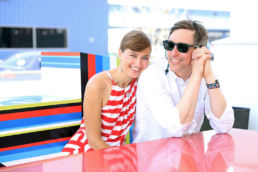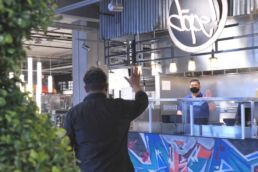words TRISH RICHTER | photography GINA WEATHERSBY
Fixed in the hub of downtown Cincinnati, the Contemporary Arts Center holds a long-standing, synergetic relationship with our community. The CAC’s generous and responsive relationship with the city can be witnessed through the recently established free admission; its Education Department’s deep and broad spectrum of programming which serves thousands of children and adults every year; and the Education Department’s most recent fundraising endeavor, the publication of Cuisine Art Cocktails: Celebrating Contemporary Cincinnati.
Organized and overseen by the CAC docent program, what initially began as a seemingly small, simple idea evolved into a remarkable interdisciplinary project that plays testament to the collaborative spirit of Cincinnati.
Euphemistically referred to as a cookbook, this coffee table book of art is comprised of contributions from key players in Cincinnati’s food scene, including chefs, mixologists, restaurateurs, and sommeliers, who donated their time and talent to support this community funded project. Each contributor was asked to choose a work of art that has been featured at the CAC and respond with a dish or cocktail. The result is the cross fertilization of these multisensory fields, realized in this innovative book featuring 4 cocktails and 26 original recipes complete with wine pairings by Kevin Hart.
Raphaela Platow, CAC Alice & Harris Weston Director, said that this was not only a way to celebrate contemporary Cincinnati but also to tell the CAC’s story. “I meet so many people who think that we were founded when we relocated to the Lois & Richard Rosenthal Center for Contemporary Art, but we’ve been around since 1939. This was another opportunity to show what we’ve done in this city and how much support there has been for the contemporary arts in Cincinnati,” she said.
 Structured with the backbone of a timeline, the compilation follows the lifespan of the CAC, chronologically placing culinary artists with their visual artist of choice.
Structured with the backbone of a timeline, the compilation follows the lifespan of the CAC, chronologically placing culinary artists with their visual artist of choice.
Project designer, long-time docent of the CAC, board member, and overall muscle behind the project, Maria Kalomenidou, said that in designing the project, her goal was to facilitate a conversation between the artist and the chef. With that in mind, the design needed to be minimalistic. “It’s such an atypical book in so many ways. Since we didn’t constrain the chefs by asking them to choose an appetizer, entrée or dessert, the structure was problematic at first, but then one of our editors, Lucy Flint said, “Why don’t you curate it?”
Categorized thematically by “Of the Sea, Of the Earth, Of the Farm, and Confections,” the book is balanced by nature with a solid structure and fluidity in tone created by photographer Gina Weathersby. Undertaking the project as sole photographer (excluding the original artworks), she is widely known for her culinary photography and explained that she creates visual narratives, often between people and food. “Food was never on my photography radar, but I’m Greek. I love food. I love what it means in family , the nurturing. I understand food, and I have this overwhelming joy for bringing that across in imagery.”
Weathersby said that they felt very strongly about following through every last detail, beginning with the original artwork that inspired the chef and coming back full circle.
“I wanted to match the tone of the portraits, the atmosphere, the plating, and the ingredients. So [for] a deeper more moody type of original artwork, I’m not going to go shoot it in a fun, bright environment. For instance, I didn’t even shoot Jared Bennett in his restaurant; I took him out into the woods, because it matched his original artwork and his vision,” she said.
CAC Curator of Education, Jaime Thompson, said that it’s the atypical nature of the book that excited them. “We wanted to recognize Cincinnati’s chefs and acknowledge the CAC as this incubator and laboratory for contemporary culture and celebrate the art that it has brought to Cincinnati. Cramming that all into one book was kind of an insane idea, and I’m still amazed that we managed to do it so flawlessly. The dialogue naturally occurred between the culinary artists and visual artists,” she said.
These dialogues between art forms and the cross-fertilization between fields are brought to fruition throughout the pages. “I think what we sometimes in the contemporary world don’t talk enough about is how people inspire each other,” Platow said. “When you read about historic art, people love to talk about who inspired whom and who copied whom; that’s what art history is basically all about.
And Cincinnati is a very close-knit community. We all know each other. We all like each other, and we’re all very open to collaborating. I think there’s a real interest in connecting, partnering, and doing things together in a very interdisciplinary way. That’s a very academic term, but there’s a lot of cross over between different fields. There’s a lot of coming together and making things happen in this community, and I think that’s very unique to Cincinnati. So despite the fact that Cincinnati has maybe a more conservative foundation, I think there’s a lot of experimental qualities in this town. People are always willing to try and always willing to support,” she said.
 Fundraising can be tricky when it comes to asking people to donate their time, however, this project was met with unbridled enthusiasm. “All it took was a phone call. The chefs were all so inspired, passionate and excited to choose their artists,” Platow recounted. “What’s fascinating to me is that everybody is inspired by something different. Some researched, read and delved into the nuances of the artist’s mind, and other people were totally visual and taken by one painting, one sculpture, or one installation and didn’t need the cognitive, intellectual investigation.”
Fundraising can be tricky when it comes to asking people to donate their time, however, this project was met with unbridled enthusiasm. “All it took was a phone call. The chefs were all so inspired, passionate and excited to choose their artists,” Platow recounted. “What’s fascinating to me is that everybody is inspired by something different. Some researched, read and delved into the nuances of the artist’s mind, and other people were totally visual and taken by one painting, one sculpture, or one installation and didn’t need the cognitive, intellectual investigation.”
Unfettered by the restraints of a restaurant, cost, seasonality, or customer preference, the culinary artists were given free range to explore and create.
This liberation is brought into focus by Jimmy Gibson’s contribution. While those who know his work might expect a steak, Gibson followed the example of his artist of choice, Louise Lawler, allowing himself to be inspired by the work of another artist, a pastry chef in this case.
By capturing the work of other artists and collectors, Lawler encourages the viewer to question the spectacle of the art world’s presentation and marketing of art. Gibson depicts the evolution of his dish in four frames. “He is appropriating Louise, who is appropriating Andy Warhol, who is appropriating a press photo,” Thompson explained. “He understood the work on such a deep level. Interestingly enough, when we first met with him, he came with a piece of very old wood to create his own background. Turns out he is a painter and just never mentioned it. A closet painter if you will.”
To Thompson and Kalomenidou’s surprise, the vast majority of the contributors studied another type of art before moving into the culinary field. “Stephen Williams studied photography. Stephen Shockley is also a visual designer. Ileana Saldivia is an architect by trade and became a cake designer. She works like a designer with a very clear-cut creative process, but her sketchbook that she uses for clients is a piece of art filled with tiny sketches of all these very elaborate and complicated cakes,” Kalomenidou said.
“We let them be the artists that they are,” Thompson said. “One of the things that’s great about the CAC is that it stretches your understanding of what art can be, and that’s what we love about our programs; we want to encourage people to realize that art is a part of your everyday life. I think a lot of the time chefs feel like they don’t have the freedom that an artist has in the gallery. It was really great to be able to give that to them.”
Having grown up in Cincinnati, Megan Ketover, pastry chef of Orchids at Palm Court, remembers field trips to the CAC and being amazed by how other classmates viewed art. “It’s the same feeling I get when I look at dishes created by other chefs––how they produce something completely different than I would from the same ingredients. The art that surrounds us in both the visual and culinary form is a way of starting conversations about our world and helping us find common ground with others.”
It’s this receptiveness to others’ voices and to our own voice that creates a starting point for these conversations. Weathersby explains that when she teaches workshops, the first thing she discusses is finding your voice and showing it through your work. “Nobody needs to see the same thing that everybody else did. Why would you want to be someone else? What you have to say is so much more interesting. Somebody else can write. Somebody else can take photography. I don’t care what kind of artist you are; the only thing that sets you and another artist apart is your voice,” she says.
Stories about the CAC’s influence on these artists’ lives and memories of experiencing particular exhibitions kept finding their way to Thompson throughout the project’s development. “There is a loyalty to the museum that I’ve seen with our visitors, but because I spend so much time inside the building, I was surprised when we started working with the chefs by how much we’re loved throughout the community. It was honoring and humbling.”
Platow recruited the talent of Lucy Flint, an editor out of Boston, Massachusetts, who she has entrusted with most of her writing since coming to the United States. “I trust her entirely,” she says. “She is so talented in leaving your voice intact while condensing and shifting things around a bit, tailoring beautiful essays.”
 Flint and her daughter, Emma Gohlke, were also major forces behind the project. As a sculptress with expertise in the culinary arts, Emma basically test cooked all of the recipes. “She made them all homogenous because some chefs would use one kind of language to describe what they were doing or use one type of measurement while another chef would use another. Starting out we didn’t realize we would need a recipe tester,” Platow says.
Flint and her daughter, Emma Gohlke, were also major forces behind the project. As a sculptress with expertise in the culinary arts, Emma basically test cooked all of the recipes. “She made them all homogenous because some chefs would use one kind of language to describe what they were doing or use one type of measurement while another chef would use another. Starting out we didn’t realize we would need a recipe tester,” Platow says.
This book is very much a platform for this spectrum of Cincinnati voices, allowing the contributors the space to speak to their art and to why this project and the artists inspired them.
“I’ve not seen another book like this, and we have so many books,” Weathersby said. “Who needs another book? Who needs another magazine? Make it something seriously different, like Deogracias is doing with Polly. It’s his voice. He’s not trying to copy something else. Yes, it’s a magazine, but make it your own. This is fresh, interesting, exciting and circles back to educate our community.”
The CAC’s educational programs focus on age ranges from early childhood to those who suffer from memory loss and dementia. Drink and Draw, the free coloring session in the lobby, reaches out to millennials; Thursday Art Play provides a creative play time for the youngest visitors; and One Art, One Craft provides opportunities for adults to get back into the world of making.
“Traditional art educators are consistently baffled by the strange and unusual programming that we do here,” Thompson said. “And I say strange and unusual because it’s not traditional art making. And one of the things I’m hoping this book does is help people discover that art is all around them, that’s what we do with our programs. We just want people to embrace that there is a place for aesthetics in all of our lives, and it makes our world better in one way or another.”
The CAC’s school outreach programs accommodate just under 2,000 students by providing a visit to the museum by way of paying for a bus or by going into the classrooms. Because of early sales from the book, the CAC has allocated an additional $2,000 for buses to bring students into the museum next year. This can only blossom with the upcoming Gala and Art Auction on August 26, in celebration of the publication. Chefs and mixologists will be on hand preparing dishes and drinks featured in the cookbook.
“This level of participatory education is what the city hungered for, so we answered,” Thompson said. “In the last two years we’ve seen more than a double increase in attendance to these events. We’ve seen our visitors change, our attendance change, and we’ve certainly seen our town change. We would never be able to do this if it weren’t for our docents and the incredible collaboration and engagement from the entire community,” she said.
Our city’s natural ability to collaborate and raise each other up collectively has brought this vision to fruition. This vision serves as yet another extension of the CAC’s mission to educate, discuss and engage.
On their website, you can find information on the gala, purchase the cookbook, and support the CAC’s project.



